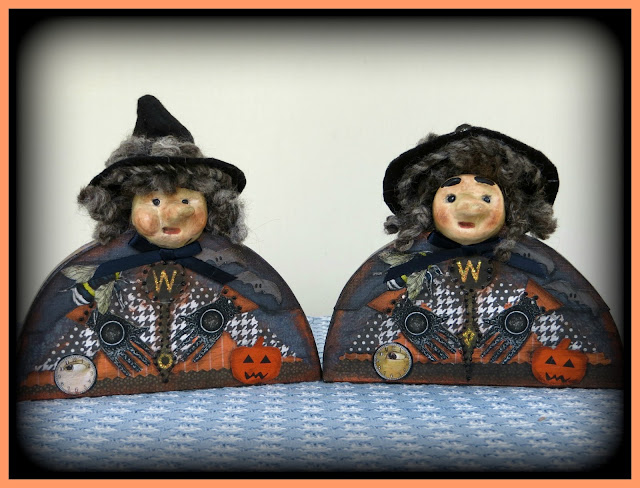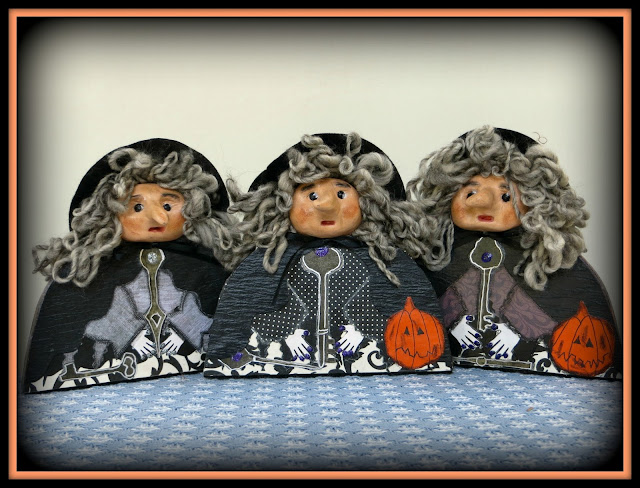As you know I love the Fall, Halloween, and Thanksgiving season. So, when I saw the Moonlit Treaters Mill Hill #MH14-1724 cross-stitch kit I wasn't surprised that I was drawn to. Halloween, ghosts, witches, and Dracula - what's not to love!
The Moonlit Treaters Mill Hill pattern uses full cross-stitch and straight stitch highlighting as well as beads of various sizes for emphasis and depth. The Mill Hill patterns usually call for certain areas of the perforated paper to be left untouched like the background or border. In this case they were leaving sections of the dark blue perforated paper border untouched.
Personally, I don't like the dark blue perforated paper as I find it hard to count the holes and follow along as to where you are on your cross-stitch. Since I always finish the background of all my cross-stitch pictures I decided to stitch my picture on the lighter brown colored side of the perforated paper.
In embroidering the cross-stitch I decided to once again utilize the rectangular wood frame jig that my darling husband built for me that I could tape the edges of my perforated paper to. The wood frame jig is a rectangular embroidery hoop of sorts, but without bending the perforated paper. He had made it out of 1/2" x 1" pine wood strips with an adjustable center strip that I used for this 5.25 x 5.25 square design.
I had learned from previous mistakes that I needed to draw diagonal lines to locate the exact center of the perforated paper as in previous perforated paper cross-stitch picture I have done the picture was slightly off center by a few holes which caused a problem with inserting the needles in the holes along one of the edges of my frame. So, I lightly drew a diagonal line across each corner with a pencil to get the center point of the perforated paper.
A lot of the cross-stitch 5.25" by 5.25" pictures I have made were finished in small 6 1/2" by 6 1/2" shadowbox frames with 5" by 5" openings that I had gotten at Michaels when they went on sale one year. I used up all the shadowbox frames I had gotten previously and have been looking for them ever since and hadn't been able to find that size again.
I did, however, find some 7" x 7" by 1 1/2" shadow box frames with a 5 1/2" x 5 1/2" opening at Michaels last year and bought a few white ones and black ones when they were on sale. I was hoping to use one of the white ones with this project.
The directions did not include any instruction for finishing the back. I decided to finish mine with thin adhesive press-board paper. I used an 8" by 10" Pres-On sheet that I cut 6" by 6"with kitchen scissors to fit my picture. The shadow box came with a padded velvet sheet glued to the rigid back of the shadow box frame which was about 1/4" thick. My cross-stitch picture glued to the thin adhesive press-board paper was about 1/8" thick so I knew this would be a good fit once I removed the black velvet padding fabric that had been glued to the rigid back of the shadowbox.
After adhering my cross-stitch picture to the 6" by 6" thin adhesive press-board paper I inserted it into the back of the frame and then inserted the 6" by 6" rigid back that came with the frame over it. The shadow box frame came with 8 metal clips to hold the rigid back inside the frame which I secured. The press-board fit perfectly and was the right depth for the shadow box frame.
The pattern called for a blue colored wooden frame and for the border of the perforated paper to be left untouched like the picture shown below:
However, I don't like seeing the perforated sections of the paper for the border as I think it makes the cross-stitch picture look unfinished and opted instead to finish the border with black colored DMC embroidery floss sewn as a half cross-stitch using three strands of the floss.
As I was inserting this into a black colored shadowbox, I wanted to differentiate the black background area around the picture from the picture itself so I inserted orange floss sewn in a back-stitch around the edge of the picture using 2 strands of bright orange DMC embroidery floss.
The pattern called for some outlining. Given I was putting this in a black shadowbox I thought certain sections of the picture would benefit from some additional outlining so I decided to add more definition as follows:
1) The pattern called for one strand of the black floss to be back-stitched around all the bats and chimney pipe of the house. I opted to use two strands of the black floss instead.
2) The pattern called for one strand of the black floss to be back-stitched around certain borders around the windows. I opted to use two strands of the black floss and back-stitch outlined around all sides of the windows and the middle sections.
3) The pattern did not call for any outlining definition around the frame and sides of the house. I opted to use two strands of the black floss and back-stitch outlined the frame and sides of both houses. I also added two strands of the black floss along the left hand side of the walkway.
4) The pattern did not call for any outlining around the Halloween trick-or-treaters. I opted to use two strands of the black floss and back-stitch outlined around the left hand sides of all three individuals, as well as around the ghost hat. I also added two strands of medium gray floss along the right hand side of the ghost.
5) The pattern called for one strand of the black floss to be back-stitched to create the metal fence. I opted to use two strands of the black floss instead.
6) The pattern called for one strand of the black floss to be back-stitched around the witches hands, handle of the pumpkin bag, and Dracula hand. I opted to use two strands of the black floss instead.
7) The pattern called for one strand of the white floss to be back-stitched for the stars in the sky. I opted to use two strands of the white floss instead.
While the end results of this design were wonderful some things in the kit and in the instructions could be improved upon so I'd like to offer the following constructive suggestions:
The cross-stitch chart was in black and white as was the floss color code and symbol key. The color code and symbol key was easy to read. The chart was basically easy to read except there was a symbol used in several sections under the metal fence highlighting that was not included in the symbol key. I thought I could see what color they wanted from the picture on the front but it was too small to determine what to do there. I opted to use two strands of the orange floss and cross-stitch those sections.
While I basically had no problem with the chart and keys I did have a problem with the way the DMC floss was presented. All of the floss was tied together in one big knot so you had to separate the floss pieces yourself, sort them, and try to interpret which color belonged to which floss # and symbol key on the color chart.
If you only have a few colors to deal with this isn't a problem. However, if you have several different colors to choose from that are close in color then interpreting the chart can be tricky. You may assign the wrong color to the wrong symbol if the colors are too closely aligned. The key code chart should have contained the number of strands that were included in the kit so I would know how many strands I had for the different floss colors.
As I have done with other cross-stitch kits I've completed I had to design my own thread color sorter and symbol key. I took a piece of thin cardboard and cut a 1" x 9" long rectangular piece out to use as a thread sorter. I then punched holes in my cardboard strip in which to tie each of the different colors. Just above the hole I wrote the DMC floss # and just below the hole I added the respective cross-stitch symbol. I then inserted the floss threads that went with that # and symbol through the hole and tied them in a loose knot. This kit could be much improved if a thread sorter with respective #'s and symbols was provided.
The beads were contained within three small ziploc bags which was fine. The chart had footnote symbols to help distinguish which beads were within which bag.
The kit included a cat button was to be sewn to the bottom right hand section on the bottom of the picture. I didn't like the cat button so I decided not to use it.
My results with the totally finished background, border and frame is shown below:
Despite the relatively small issues I had encountered with the kit I was happy with the way my picture turned out.
As always, my comments are meant to be constructive to enable future purchasers to benefit from my experience and to enhance their ability to create a wonderful little cross-stitch design.





























